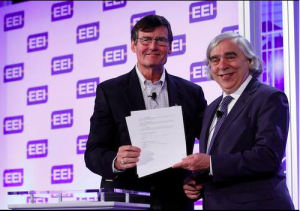Intel is participating in a unique pilot wind power project. The company is installing 58 micro-turbines on the roof to help renewably power their building. According to Marty Sedler, director of global utilities & infrastructure for Intel, the project came about due to their ongoing efforts to find more sustainable ways to use technology. This is why, he said, Intel began piloting one of the world’s largest operating rooftop arrays of wind micro-turbines on the roof of its worldwide headquarters in Santa Clara, California.

Rendering of the planned installation of 58 Wind Micro-Turbines on the rooftop of Intel’s global headquarters building in Santa Clara, California. The installation is underway and will be complete in May 2015. IMAGE SOURCE: JLM Energy, Inc.
Sedler explained that the micro-turbines are a proof-of-concept project, in which Intel hopes to collect data that could help the company better support green power applications and identify ways to continue evolving its sustainability programs. Intel also hopes the project will inspire other companies and electric users to consider creative new options to conserve energy.
Many companies, such as Intel, are not in a position to install full-scale wind turbines on their property. This is why the company partnered with JLM Energy, a Rocklin, California-based company that built and installed the micro-turbines. Sedler said each micro-turbine is between 6 and 7 feet tall and weighs approximately 30 lbs. The model of micro-turbine that Intel is using is the smallest design available for commercial buildings and is considered the most efficient turbine in its size class. Due to their small size, the micro-turbines are versatile in their potential uses and applications, said Sedler.
Each micro-turbine generates approximately 65 kWh. The array was sized to provide the electricity required for the lighting and general operation of Intel’s Executive Briefing Center. Sedler explained that since the micro-turbines need no fuel other than wind, they produce green power at no additional cost. For every kWh of green electricity the micro-turbines produce, Intel will require one fewer kWh of grid power, therefore reducing the need for power sources that produce much higher levels of greenhouse gas (GHG) emissions.Read More










